Exploring the Allure and History of the Hope Diamond
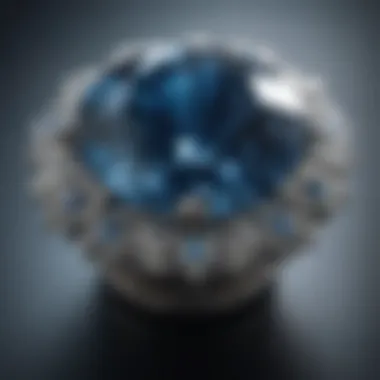
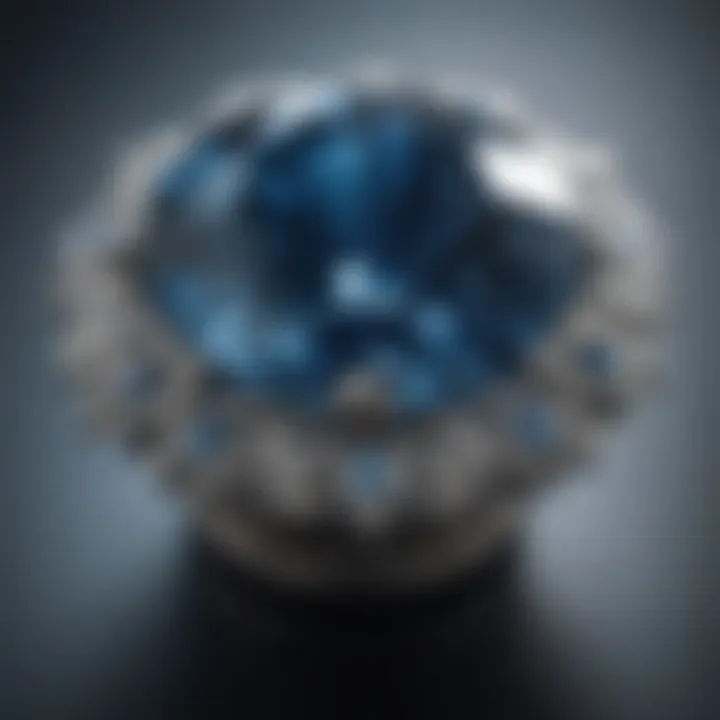
Intro
The Hope Diamond has captivated the hearts and minds of gemstone enthusiasts and casual observers alike. It’s not just a remarkable stone in terms of size and color but also its enthralling history. This portion of the article will pave the way for a deeper dive into the multifaceted nature of the diamond, exploring its journey through time and space.
The diamond, with its stunning blue hue, has stories that span across continents and centuries. At its core, it’s a tale of beauty, intrigue, and, yes, a hint of doom, popularly linked to its so-called curse. However, to truly appreciate what the Hope Diamond represents, one must first step back and understand the broader context of gemstones and their significance.
Gemstone Overview
Definition of Gemstones
Gemstones are naturally occurring minerals that possess beauty, rarity, and durability. A gemstone must endure the test of time; in other words, they should not just be pretty rocks. To classify as a gemstone, the material typically has to withstand polishing and cutting, standing firm against the elements. They are often set in jewelry or collectibles, but their value transcends their physical form — they carry stories, beliefs, and cultural significance.
Classification of Gemstones
Gemstones are broadly categorized into two main groups: precious and semi-precious stones. The term "precious" is reserved for gems like diamonds, rubies, sapphires, and emeralds, often marked by their exquisite color and rarity. On the other hand, semi-precious stones include a diverse array like garnets, amethysts, and opals, generally more abundant but still cherished for their unique beauty.
Some gemstones, like the Hope Diamond, may start in the semi-precious category but, due to unique characteristics or historical significance, can end up being considered precious in societal terms. Here’s a simple breakdown:
- Precious Gemstones:
- Semi-Precious Gemstones:
- Diamonds
- Rubies
- Sapphires
- Emeralds
- Amethyst
- Garnet
- Topaz
- Opal
"A diamond is a chunk of coal that did well under pressure." - Henry Kissinger
The Hope Diamond, with its rich blue color and intriguing history, certainly qualifies as one of the most celebrated gemstones in the world.
Historical Significance
Origins of Gemstone Use
The usage of gemstones dates back to ancient civilizations, where they were often attributed with mystical powers or used as symbols of wealth and status. The traditions surrounding gemstones vary across cultures, from ancient Egypt to the courts of Europe. While some cultures believed these stones could offer protection or healing, others simply used them as lavish adornments.
Throughout history, the allure of gemstones has not waned; rather, it has evolved. Each gem, including the illustrious Hope Diamond, carries tales of battles, treasures, and myths that help forge its identity.
Cultural Insights: Gemstones in Ancient Civilizations
In ancient Indian culture, gemstones were linked closely with astrology and were believed to possess divine properties that influenced one’s fate. For instance, the practice of wearing a specific gemstone to improve fortune still resonates today in certain traditions.
In contrast, ancient Romans viewed gemstones primarily as symbols of power and status, with emperors adorning themselves in gems to showcase their might.
Thus, the narrative around gemstones encapsulates a blend of beauty and cultural significance. It sets the stage for understanding the Hope Diamond not just as a rare geological marvel, but as an object interwoven with historical events and human emotions.
Foreword to the Hope Diamond
The Hope Diamond, with its deep blue hue and fascinating backstory, holds a prominent place in the world of gemstones. It’s not just a pretty bauble; it’s a rich tapestry of history, myth, and cultural symbolism that spans centuries. Understanding the significance of this jewel is not only intriguing but also essential for gemstone enthusiasts and collectors who look for depth in their acquisitions.
With its origins tracing back to India, the diamond’s journey reveals layers of the societies and historical developments it has influenced. It’s something of a time capsule, offering insights into the values and aesthetics of different eras while showcasing the craftsmanship involved in jewelry design throughout the years.
In this section, we’ll delve into the essential facets of the Hope Diamond’s story. By breaking down the characteristics that give it its allure, as well as exploring its impact culturally, we’re setting the stage for a comprehensive understanding of what makes this gemstone legendary.

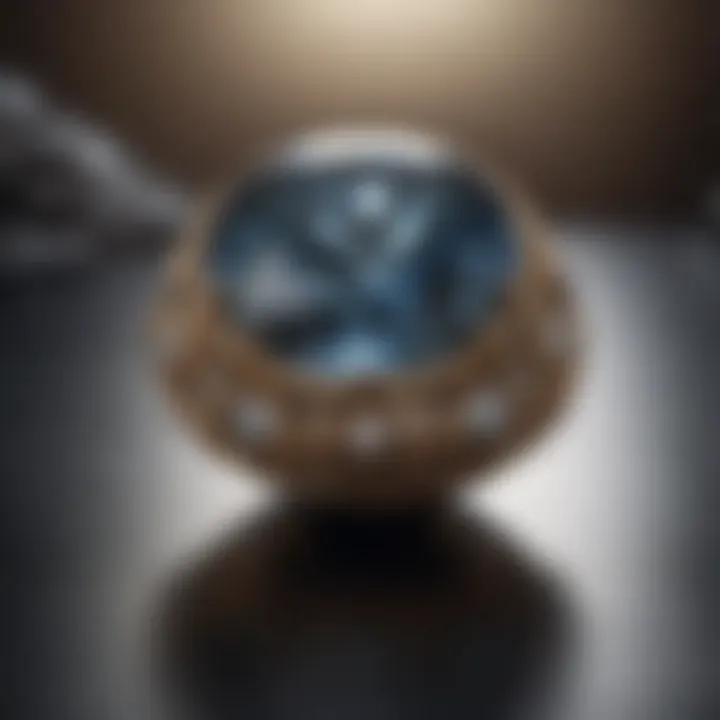
An Overview of the Gemstone
At its core, the Hope Diamond is a remarkable example of nature's artistry. Weighing in at 45.52 carats, this diamond is not one to be trifled with. Its unique color, defined as Fancy Dark Grayish Blue, results from a combination of trace elements, particularly boron, giving it a quality that is both rare and sought after by collectors.
Visually, the diamond is cut in a cushion shape, allowing light to dance through it in a captivating manner. Unlike other gemstones that might boast clarity above all, the Hope Diamond embraces its imperfections, revealing a character that feels alive. The depth of its color and the way it catches the light speaks volumes, even more than words ever could. It's a gemstone that tells its own story with every glint.
Many people might come across gemstones daily, but this one hits differently. The weight, color, and the myth of its supposed curse conjure a deeper interest, prompting questions about not just the stone but also the person behind every ownership.
Cultural Relevance Over Time
The Hope Diamond represents more than its material value; it has permeated various cultures and artistic expressions over time. The gem has made its appearances in literature, art, and popular media, serving as a potent symbol of both beauty and tragedy. Here are a few notable examples:
- Artistic Representation: The diamond has inspired numerous artists and writers who have incorporated its mystique into their works. Artists like Jean Cocteau have used it as a metaphor for fate, intertwining humanity's relationship with beauty and desire.
- Mythology and Folklore: Rumors surrounding the diamond's curse have fueled countless legends. Tales of misfortune and calamity befalling those who possess it continue to captivate imaginations.
- Symbol of Status: Throughout history, owning the Hope Diamond was not merely about wealth; it was an emblem of social standing. It signified dominance among aristocrats and royalty, adding to its mystique and appeal.
As we step through the ages, it becomes evident that this diamond is not stuck in a bygone era; it continues to resonate in contemporary discussions on ethics in ownership and the value assigned to tangible beauty. It's a reminder that what shines brightly can often cloak deeper narratives, and the Hope Diamond is no exception.
Historical Background
The rich tapestry of the Hope Diamond’s history is integral to understanding its significance and allure. It’s not just a beautiful gemstone; it embodies stories of ambition, lust, and tragedy. Its journey from the depths of ancient mines to the illuminated display cases of modern museums illustrates an odyssey that speaks volumes about the cultures and countries it has touched. By delving into its historical background, one unveils the narratives that have shaped not only the diamond itself but also the people associated with it.
Origins in India
The Hope Diamond traces its roots back to India, specifically the Golconda mines. These mines were renowned for yielding some of the world's most magnificent stones. The blue hue of the diamond comes from the presence of boron, giving it an otherworldly appearance that fascinated jewelers and collectors alike. Originally known as the "Sancy Diamond," it was likely part of a larger stone, which was artfully cut and polished by artisans of the era. The miners worked hard in treacherous conditions to extract these precious gems, bringing incarnations of beauty and splendor to eager markets.
In a sense, these mines were more than just sources of wealth; they were cultural epicenters. They attracted merchants and buyers from far and wide, culminating in a trade that spanned continents. The Hope Diamond, like many gems of its kind, became a symbol of power and status, exchanged among royals and noblemen. Its Indian origins are thus embedded not only in its physical properties but also in its narrative—a testament to a bygone era when gemstones carried the weight of social and economic significance.
The Diamond's Journey Through Europe
As the Hope Diamond made its way to Europe, its journey became marked by twists and turns that would change its fate forever. The diamond first appeared in France in the 17th century, purchased by King Louis XIV, who was known for his lavish tastes and essential interest in the arts. The diamond was incorporated into the royal jewelry collection, capturing the fascination of the French court.
However, the diamond's tale was far from smooth. After the fall of the monarchy during the French Revolution, the Hope Diamond vanished for a time, leading many to speculate about its whereabouts. It reemerged in England, changing hands several times through shady dealers and opportunistic sellers. Each new owner added layers to its storied past, contributing to the diamond's reputation as a harbinger of misfortune.
Key Figures of Ownership
The story of the Hope Diamond is intertwined with key individuals who shaped its past. Among these figures is Pierre Cartier, a renowned jeweler and innovative marketer. In the early 20th century, Cartier managed to acquire the Hope Diamond and set it in a unique corsage ornament. His marketing prowess detailed the diamond's so-called curse, turning the narrative into a thriving spectacle.
Throughout its lineage, the diamond has belonged to notable figures, including the American socialite Evelyn Walsh McLean. McLean's ownership further cemented its reputation; her life was marked by tragedy and loss, adding to the legend of the diamond. From kings and queens to modern-day collectors, the Hope Diamond has seen a wide array of personalities—each adding their own chapter to its already voluminous history.
In sum, the historical background of the Hope Diamond is not merely a timeline; it is a narrative brimming with cultural significance, economic power, and personal stories. Understanding the men's and women's influence over the diamond offers richer context to its present-day allure and enduring fascination.
Physical Characteristics
Understanding the physical characteristics of the Hope Diamond is crucial. These attributes not only highlight the gem's distinctive beauty but also contribute to its legendary status in the world of precious stones. The diamond's color, clarity, cut, and carat weight make it unique and desirable among collectors and enthusiasts alike. Each element reflects the craftsmanship behind its formation and guides connoisseurs in assessing its value and beauty.
Color and Clarity
The Hope Diamond exhibits a captivating blue hue that sets it apart from other gems. Its rich and vibrant blue is a result of trace amounts of boron, which can be quite rare in diamonds. Unlike a standard diamond that may appear colorless or slightly tinted, the Hope Diamond’s color is its crowning glory, viewed as both luxurious and enchanting. Experts describe its shade as deep, saturated and incredibly striking, often attributing emotional responses to its vividness.
Clarity, too, plays a role in how this diamond is appreciated. The Hope Diamond exhibits a type of clarity known as "VS1," meaning that it contains only slight inclusions that are difficult to detect. It’s these tiny imperfections—the natural fingerprints of Mother Nature—that add character to the stone. Ultimately, the interplay of color and clarity not only enhances its aesthetic appeal but also impacts its market value significantly.
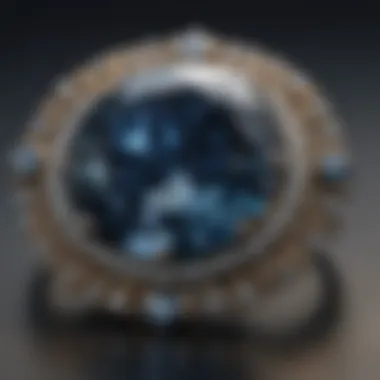

Cut and Carat Weight
When it comes to the cut of the Hope Diamond, many would recognize its cushion cut, which presents a rounded square shape. This particular cut is not just about surface appeal; it’s designed to maximize the diamond's brilliance and fire, allowing light to dance within its facets. The original stone was much larger before it was recut, but the current cut optimizes its glowing beauty. A well-cut diamond reflects and refracts light in such a way that it delivers an exquisite play of colors.
In terms of carat weight, the Hope Diamond weighs an impressive 45.52 carats. This considerable size contributes to its allure and makes it one of the largest blue diamonds in existence. For comparison, many collectors may often seek diamonds around the one-carat range, making the Hope stand out significantly in any showcase. The term 'carat' itself is derived from the carob seeds once used as a unit of measure for precious stones—a fact that adds a historical twist to the storied gem.
Comparative Analysis with Other Notable Diamonds
When putting the Hope Diamond alongside other renowned diamonds, interesting contrasts arise. For instance, the Hope is frequently compared to the Blue Moon Diamond and the iconic Koh-i-Noor. The Blue Moon, weighing in at around 12.03 carats, is admired for its lighter tone, while the Koh-i-Noor, at a staggering 105.6 carats, holds historical significance tied to royalty.
In the same breath, diamonds like the Cullinan highlight fascinating intricacies. Weighing a whopping 3,106 carats before cutting, it became a symbol of privilege and grandeur, much like the Hope but from a different narrative. While size and cut vary greatly among these stones, the allure of the Hope Diamond remains unparalleled, often seen as a jewel shaped by both myth and reality.
In summary, the physical characteristics of the Hope Diamond provide a deeper understanding of its uniqueness. From its remarkable color and clarity to its astute craftsmanship in cut and substantial carat weight, this gemstone tells a story as rich and colorful as its appearance. It's more than just a beautiful gem; it's a captivating element in the vast tapestry of gemological history.
Myths and Legends
The Hope Diamond, with its sparkling allure and storied past, is not just a gemstone; it's a talisman of myths and legends that has captivated imaginations for centuries. Understanding these narratives helps to unravel not only the diamond’s dramatic history but also the psychological and cultural impact it has exerted. Within this framework, tales of curses and interpretations of fortune highlight intrinsic human fears and aspirations, showcasing how you neglect the stories behind gems, you'd miss the vastness of their meaning and symbolism.
The Curse of the Hope Diamond
One of the most fascinating aspects surrounding the Hope Diamond is its reputed curse. The legend proclaims that misfortune befalls those who possess it. From its early years in India through to contemporary ownership, stories of adversity are as common as the diamond's changing hands.
For instance, the diamond has been linked to a string of tragedies involving its owners. Consider the case of King Louis XVI and Marie Antoinette, who met their demise during the French Revolution. Many believe that the diamond's arrival in their possession foreshadowed their grim fate.
As the diamond shifted across various continents, it purportedly left a trail of sorrow behind it:
- An early owner, Henry Philip Hope, faced ruin and disgrace.
- American socialite Evalyn Walsh McLean, who owned the diamond in the 20th century, experienced numerous personal tragedies, including the deaths of her children and her husband.
This idea of the curse extends beyond mere superstition. It speaks to a deeper anxiety that envelops us when we attach immense value – both monetary and sentimental – to objects. Even today, some might whisper about jinxed fortune when they think of this gem. A common tongue-in-cheek expression in jewel circles is, "Better to admire from afar than to hold and suffer thin air!"
Cultural Interpretations of Luck and Fate
Across cultures, gems often embody deeper meanings, serving as metaphors for luck and fate. The Hope Diamond is no exception. In some circles, it is deemed a harbinger of ill fate, reinforcing the narrative of misfortune. Yet, in other interpretations, it emerges as a powerful amulet that brings protection to its bearer.
- In the world of jewelry design, artisans often play with these dual interpretations. Many create pieces imbued with the essence of the diamond’s storied past, integrating symbols of luck to either ward off negativity or invite good fortune.
- Within Western folklore, the idea of the 'cursed diamond' has melded with contemporary culture. Many films and books portray the Hope Diamond as a dark artifact, with its owner on the precipice of calamity.
Alternately, the diamond's rich hue has led some to view it as a symbol of allure and fascination, suggesting that beauty often comes with peril. To some, its spectral blue is a reminder that life’s path is strewn with risk but also steeped in possibility.
"The stories we tell ourselves about objects can shape their reality more than their intrinsic value ever could."
To truly appreciate the Hope Diamond's significance and allure, understanding these myths and legends is crucial. They not only illuminate the diamond’s journey but also reflect the human condition—our desires, fears, and the many layers through which we perceive fortune and fate.
The Hope Diamond in Popular Culture
The Hope Diamond has transcended its existence as a mere gemstone, cementing its place in popular culture over centuries. This multifaceted stone, with its striking depth of color and notorious history, has evolved into a symbol of beauty and mystery. Its involvement in literature, cinema, and jewelry design showcases how it has captured the imagination and intrigue of many, proving that some stories extend beyond their historical roots.
Representation in Literature and Film
The allure of the Hope Diamond has inspired countless narratives. It seems that wherever a tale involves a magnificent gem, the Hope Diamond often finds its way in.
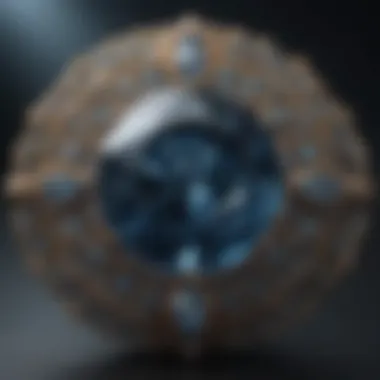
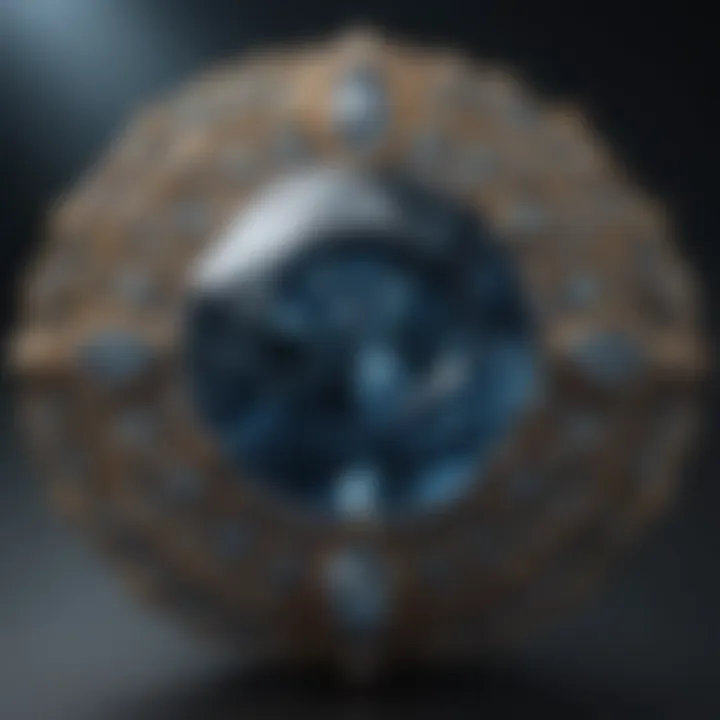
- Literary References:
- Cinematic Appearances:
- The gemstone has graced the pages of novels and stories that delve into its legend. Authors often use it as a vehicle to explore themes of greed, love, and tragedy. Its reputed curse often amplifies tension and drama in various plots.
- For instance, in the tale The Curse of the Hope Diamond, the assembly of characters from different walks of life is drawn to the gemstone, each with their own motives, sometimes leading to dire consequences.
- Its cinematic presence cannot be overstated. Notable films such as The Great Gatsby feature the diamond as an object of desire, embodying wealth and the darker side of aspiration. The stone's capture in film often parallels the intricate dance between beauty and peril, making it an effective plot device.
- Documentaries and explorative pieces delve into its storied past, granting audiences a glimpse into its journey and significance. These films highlight the diamond’s events of disaster surrounding it, emphasizing the narrative of misfortune that trails closely behind it.
Influence on Jewelry Design Trends
The Hope Diamond's influence on jewelry design is both profound and palpably evident. Its unique characteristics not only inspire jewelers but also shape trends in various cultures and eras.
- Design Innovations: The diamond’s cut and color inspire designers to experiment and innovate. Jewelry collections featuring deep hues echo the Hope Diamond’s mesmerizing blue, leading to the creation of pieces that capture its essence, often pulling onlookers into a whirlwind of admiration.
- Historic Pedigree: Pieces of jewelry inspired by the diamond often reference its illustrious history. Collectors and enthusiasts sometimes seek out designs that mimic its iconic style to either adorn themselves or commemorate the history of gemstones. These designs cater to those with an appreciation for the complex narratives gemstones embody, from curses to conquests.
- Fashion Statements: The diamond’s presence in the fashion industry also elevates the significance of high-end jewelry, instilling a desire for similar opulence. Designers utilize the diamond's famed reputation to market contemporary designs, blending tradition with modern flair.
"The Hope Diamond isn’t just a stone; it’s a story etched in the annals of history, capturing hearts and minds across generations. Its influence is enduring and shapes how gems are perceived even today."
In summary, the Hope Diamond remains a fixture in popular culture, connecting disparate elements of narrative and artistry. Its representation in literature and film allows it to serve as a catalyst for the imagination. At the same time, its impact on jewelry design trends highlights how a single gem can spark creativity and innovation. In an age where fleeting trends abound, the Hope Diamond continues to endure, inspiring those who seek both beauty and meaning in the world of gemstones.
The Hope Diamond Today
In the present era, the Hope Diamond remains more than just a gorgeous piece of jewelry; it is a symbol of a compelling history, intricate craftsmanship, and continued fascination. Its presence in today's world reflects the intersection of luxury with cultural heritage, drawing in not just gemstone enthusiasts but also historians and casual admirers. Understanding the Hope Diamond today involves exploring its ownership, display, insurance valuation, and the impact it leaves in the market.
Current Ownership and Display
Currently, the Hope Diamond is housed in the National Museum of Natural History in Washington, D.C. This museum, part of the Smithsonian Institution, offers visitors a chance to view the diamond up close, nestled in a stunning, custom-made setting designed to enhance its fiery blue beauty. Having passed through countless hands over its storied past, the diamond now rests under the careful stewardship of the museum.
Visitors flock to see the diamond, often drawn by its allure as much as its lore. Unlike typical jewelry displays, the Hope Diamond is not merely a feast for the eyes but a portal into centuries of history. Tourists and gem aficionados can spend hours captivated not just by the stone itself but also by the stories it carries.
"The Hope Diamond's story stretches across continents and eras, making its display a rich tapestry of history and artistry."
The exhibition showcases not just the gemstone but also detailed narratives about its origins and ownership. Such a display intends to educate guests about not only the beauty of the diamond but also its sometimes tumultuous history. Collectors, historians, and tourists alike come away with a sense of the diamond's significance beyond mere aesthetics.
Insurance Valuation and Market Impact
When it comes to insurance valuation, the Hope Diamond stands out, even among valuable gems. Determining a definitive monetary value for the diamond is complex due to its unique characteristics and illustrious history. It has been valued anywhere from 200 to 250 million dollars, mainly for its cultural rather than just market worth. Insurers often consider factors like provenance, rarity, and historical significance, which adds layers of complexity to valuation.
The Hope Diamond's impact extends beyond just insurance; it has served as a barometer for the gemstone market. Its high visibility has raised awareness about the gemstones market and sparked interest in acquiring blue diamonds. The aura surrounding this diamond often influences trends in jewelry design. Designers may draw inspiration from the Hope Diamond when creating pieces, integrating its characteristics into modern settings to resonate with today’s buyers.
Finale
The conclusion embodies the pivotal essence of this article, harmonizing the intricate themes surrounding the Hope Diamond. Its significance stretches beyond mere aesthetics; it represents a historical narrative interwoven with cultural meaning, myths, and social implications. As a gemstone, the Hope Diamond continues to captivate gemstone enthusiasts, including collectors, jewelry designers, and geology aficionados, making it essential to analyze its many layers.
The Enduring Allure of the Hope Diamond
The Hope Diamond's allure is undeniable. It captivates not just because of its stunning blue hue, which is a result of trace amounts of boron, but also for the compelling stories that accompany it. The diamond has traveled through centuries, gathering layers of history, culture, and superstition. Many are drawn to its reputation for bringing misfortune to its owners, yet, paradoxically, it also symbolizes beauty and intrigue.
From its origins in India to its present-day display at the National Museum of Natural History in Washington, D.C., the diamond remains a connection to a thing that is much larger than itself. Its significant role in various societal contexts allows individuals to engage in a dialogue about wealth, status, and the transitory nature of material possessions.
"The Hope Diamond: not just a gemstone, but a historical chronicle etched in time."
This profound combination of attributes produces a fascination that transcends generations. It leads to continual exploration in areas like jewelry design, where contemporary artisans might draw inspiration from its brilliance and storied past.
The Lasting Impression of History on Modern Perception
History has a profound influence on how the Hope Diamond is perceived today. Each ownership phase has contributed in shaping the diamond's image in cultural consciousness. The tales of its once-royal owners and the alleged curse contribute to an aura of nostalgia and intrigue that captures collective imagination.
In the realm of modern trends, the diamond's legacy illuminates discussions about ethics in gemstone sourcing. There is a notable shift where collectors and consumers now more often seek gemstones with transparent histories. The Hope Diamond serves as a case study in this regard, illustrating the importance of provenance and ethical considerations in contemporary society.
In summary, as the Hope Diamond continues to dazzle, it leaves behind an imprint enriched with stories, ethical inquiries, and a reminder of the impermanence of opulence. This multifaceted nature keeps the diamond relevant, ensuring its place in both historical discourse and modern conversations about beauty and value.



